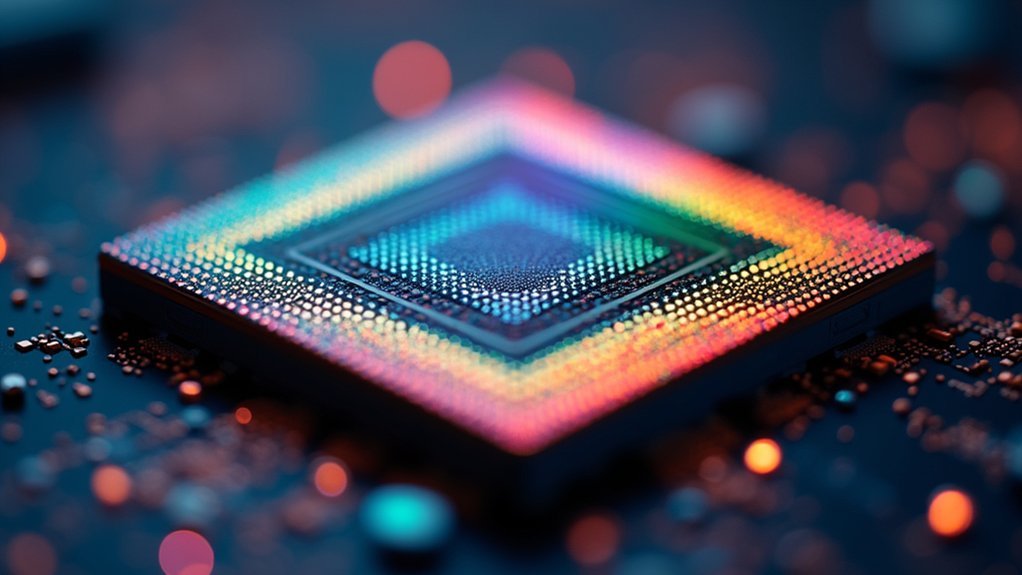Pixel size directly impacts your camera’s resolution and light sensitivity. Larger pixels capture more light but provide lower resolution, while smaller pixels offer higher resolution with reduced low-light performance. The sensor’s physical dimensions determine how many pixels can fit, affecting overall image quality. Your lens quality must match your camera’s resolution capabilities to avoid wasting potential detail. These fundamental relationships help you make smarter camera choices for your specific photography needs.
The Relationship Between Pixel Size and Light Sensitivity
When you’re examining camera specifications, pixel size serves as a critical factor in determining light sensitivity. Larger pixels have greater surface area, allowing them to capture more photons, which directly enhances performance in low-light conditions.
You’ll notice that while smaller pixels offer higher resolution, they collect fewer photons, resulting in increased noise levels, especially in dim environments. This is why sensor size matters—larger sensors with bigger pixels typically deliver superior image quality.
If you’re considering a camera with smaller pixels, look for back-illuminated sensors, which maximize light capture despite reduced pixel dimensions. This technology helps maintain sensitivity without sacrificing resolution.
Remember that pixel size greatly affects noise performance at higher ISO settings, where larger pixels consistently produce cleaner, more detailed images.
How Camera Resolution Affects Detail Capture in Microscopy
Every microscopic imaging application demands specific resolution requirements to accurately capture the intricate details of specimens. Your camera’s pixel size directly impacts your ability to resolve fine structures in microscopic samples. When pixel sizes fall below the Nyquist limit for your specimen, you’ll achieve higher resolution imaging with superior detail capture.
| Resolution Factor | Impact on Microscopic Imaging |
|---|---|
| Pixel Size | Smaller pixels increase detail capture |
| Nyquist Limit | Determines minimum pixel size needed |
| Sensor Type | Back-illuminated sensors maximize sensitivity |
| Lens Resolution | Must complement camera resolution |
| Image Quality | Higher resolution reveals finer specimen details |
Modern back-illuminated sensors allow for smaller pixels while maintaining sensitivity, enhancing both resolution and image quality. Remember that lens resolution must match your camera’s capabilities to avoid diffraction limitations and guarantee ideal microscopic imaging performance.
Balancing Magnification With Pixel Dimensions for Optimal Imaging
Finding the right balance between magnification and pixel dimensions stands at the heart of high-quality microscopy imaging. When you increase magnification, your camera’s pixel size becomes increasingly critical—too large, and you’ll lose spatial resolution at the Nyquist limit; too small, and sensitivity suffers.
- Your camera resolution must match your optical system’s capabilities
- Higher magnification requires smaller pixels to capture fine detail
- Larger pixels offer better low-light performance but limit spatial resolution
- Back-illuminated sensors can compensate for smaller pixel dimensions
- Lens aperture size interacts with pixel dimensions to affect overall detail capture
This balancing act isn’t merely theoretical—it directly impacts your imaging results. By selecting appropriate pixel size for your magnification level, you’ll achieve ideal detail without sacrificing performance in other areas, ensuring your microscopy work reveals structures with precision.
Frequently Asked Questions
What Is 3 Megapixel Resolution?
A 3 megapixel resolution gives you approximately 2048 x 1536 pixels or about 3 million total pixels. You’ll find it’s sufficient for web use and small prints while requiring less storage space.
What Is Pixel Size and Camera Resolution?
Pixel size is the physical dimension of each sensor pixel, while camera resolution is the total pixel count. You’ll find larger pixels capture more light, and higher resolution gives you better detail in your photos.
What Is the Relationship Between Pixel Size and Resolution?
Smaller pixels allow you to fit more on a sensor, increasing resolution. You’ll get finer detail with smaller pixels, while larger pixels sacrifice resolution but improve light sensitivity and reduce noise.
Is 12MP Better Than a 4K Security Camera?
It depends on your needs. 12MP offers higher pixel count for detailed still images, while 4K security cameras provide better video with higher frame rates for smoother surveillance monitoring, despite fewer megapixels.
In Summary
You’ll get the best microscopy results when you understand the critical relationship between pixel size and light sensitivity. Don’t chase higher resolution without considering how it affects image quality. When you’re capturing microscopic details, you need to balance magnification with pixel dimensions. By matching your camera’s capabilities to your specific imaging needs, you’ll achieve ideal clarity and scientific accuracy.





Leave a Reply